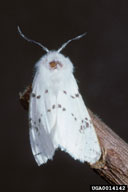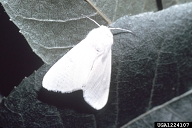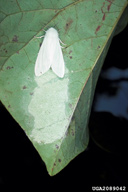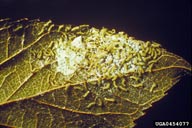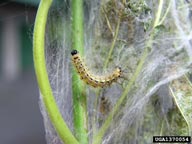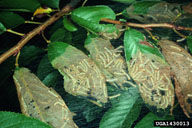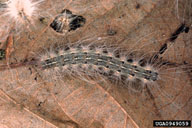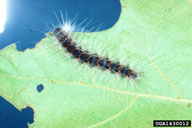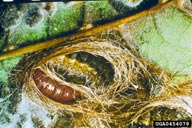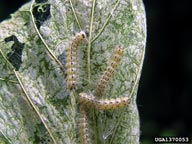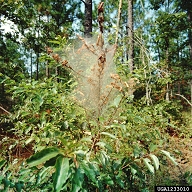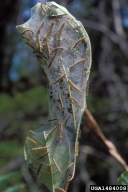Fall webworm
Hyphantria cunea (Drury) Lepidoptera: Arctiidae)
Orientation to pest
Fall webworm, Hyphantria cunea (Drury), is a native North American tiger moth, the larvae of which feed on the leaves of more than 100 species of forest and shade trees. It is found in southern Canada and throughout the United States. Adults usually fly in late spring or early summer and lay masses of eggs on the undersides of leaves. In the southern United States, adults may be present from early spring through late summer. Larvae web foliage together and feed in groups inside a web, which is expanded as the larvae grow. Young larvae are upper surface skeletonizers, but older larvae consume the entire leaf except for the larger veins. Nearly mature larvae may feed alone outside the web. Larvae move to the ground when ready to pupate, where they spin a thin cocoon in the duff. Regional color variation exists in both adults and larvae. There are one to four generations per year, with multiple generations occurring at more southern latitudes. In its native range this insect has little impact on tree health as defoliation occurs late in the year, when most nutrients are in the roots. It is invasive in Eurasia, and there the level of damage appears to be greater.
Hosts commonly attacked
Fall webworm feeds on a more than 100 species of deciduous forest or shade trees. Commonly defoliated plants include hickory (Carya tomentosa [Poir.] Nutt.), pecan (Carya illinoinensis [Wangenh.] K.Koch), walnut (Juglans) , elm (Ulmus), alder (Alnus), willow (Salix) , mulberry (Morus), oak (Quercus), American sweetgum (Liquidambar styraciflua L.), poplar (Populus) and numerous species in the Rosaceae, e.g., cherry (Prunus), apple (Malus), and hawthorn (Crataegus).
Distribution
Fall webworm is found in southern Canada and throughout the United States.
Images of fall webworm
| Figure 1. Adults of fall webworm, Hyphantria cunea, may be pure white or bear black spots | Figure 2. Left, eggs of fall webworm near adult female; right, eggs with newly hatched larvae |
| Figure 3. Left, young larvae of fall webworm; right, group of young larvae feeding | Figure 4. Left, mature larvae of fall webworm: right, larva of orange race |
| Figure 5. Pupa of fall webworm | Figure 6. Close up of feeding of fall webworm | Figure 7. Feeding and webs of fall webworm |
Important biological control agents related to this pest species
Many different species of parasitoids are associated with the larvae and pupae of this species in different locations.
Web links for information on fall webworm
- Fact Sheet | Ohio State University Extension
- Fact Sheet | Pennsylvania State University Extension
- Species Recognition and Habits Guide | L.L. Hyche, Auburn University
- Fact Sheet |
UMass Extension
From the Massachusetts Landscape, Nursery, and Urban Forestry Program - Forest Health Note |
Oregon Department of Forestry FHP
Resource for the non-industrial private forest landowner - Entomology Publication #EENY-486 | University of Florida IFAS Extension EDIS
Articles
- Morris, R. F. 1963. Synonymy and color variation in the fall webworm, Hyphantria cunea Drury (Lepidoptera: Arctiidae). The Canadian Entomologist 95: 1217-23.
- Oliver, A. D. 1964. Studies on the biological control of the fall webworm, Hyphantria cunea, in Louisiana. Journal of Economic Entomology 57: 314-18.
- Warren, L. O. and M. Tadic. 1970. The fall webworm, Hyphantria cunea (Drury). Arkansas Agricultural Experiment Station Bulletin No. 759, 106 pp.
- Yang, Z. Q., J. R. Wei, and X. Y. Wang. 2006. Mass rearing and augmentative releases of the native parasitoid Chouioia cunea for biological control of the introduced fall webworm Hyphantria cunea in China. BioControl 51: 401-418.
- Wang, Y., F. Q. Goo, Z. Xu, X. Chen, K. Li, Y. F. Xiao, S. H. Sun, and J. Y. Qi. 2010. Parasitoids and mortality of the overwintering pupal stage of Hyphantria cunea (Drury). Journal of Shenyang Agricultural University 41(6): 686-689.
